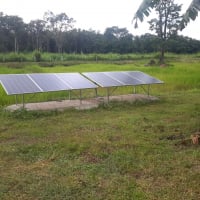Array voltage drop with pwm controller
When calculating voltage drop from my array to controller, Do i calculate for worst case voltage eg, low battery Soc 12.x volts or at pannel vmp of 16-17 volts?
Im just upgrading my cable run. Its an 8 meter round trip 4m each way and im currently running 200w through 6mm2 (10awg) cable. Im thinking of going to 25mm2 (4awg) for an upgrade to 400w of solar.
Thanks in advance for any advice.
Jim
Ps, im currently away from my setup otherwise i would take some measurements.
Comments
-
Rather than simply answering I'll give information to allow you to answer the question for yourself. Current is inversely proportional to voltage, which means as the voltage rises the current will drop and vice versa. This can be calculated using Ohm's law, V=I×R, the resistance of the conductors are however dependent on temperature, the higher the voltage drop the greater the temperature rise of the conductors which will result in an increase in resistance thus resulting in increased voltage drop.
For basic calculations let's assume conductor temperature is fixed, therefore voltage drop would be in direct proportion to resistance, as the cross sectional area increases the resistance decreases, where would you calculate the greatest potential loss? At the maximum voltage or the maximum current flow?
1500W, 6× Schutten 250W Poly panels , Schneider MPPT 60 150 CC, Schneider SW 2524 inverter, 400Ah LFP 24V nominal battery with Battery Bodyguard BMS
Second system 1890W 3 × 300W No name brand poly, 3×330 Sunsolar Poly panels, Morningstar TS 60 PWM controller, no name 2000W inverter 400Ah LFP 24V nominal battery with Daly BMS, used for water pumping and day time air conditioning.
5Kw Yanmar clone single cylinder air cooled diesel generator for rare emergency charging and welding. -
Solar panels are almost constant current devices. So a reasonable, safe value is the short circuit current (Isc) of the panels. With a PWM controller, don't take the watts, choose a voltage and then try to calculate amps. PWM systems operate at a voltage well below Vmp - so Imp isn't accurate.
I am available for custom hardware/firmware development
-
Here is a nice IV curve for solar panels... You will see that in Constant Current mode (less than Vmp/Imp point), that the current increase below Vmp is quite small:
And, for our calculations, you can use Vmp/Imp as your calculation points for the voltage drop... Although, using Vbatt+1 or 2 volts and Imp is probably more accurate for PWM type charge controllers.BB. said:I did find a copy of the orginal PDF that I used for discussion, and here are the IV curves:
http://www.solarsourcepower.com/STP175S_24Ab-1BLK.pdf
You can "rescale" this drawings to any crystalline solar panel/cell and be close enough for modeling overall behavior.
-Bill
Choosing Vmp/Vbatt=14.75+1 volts/Vbatt=12.0+1 volt/etc. does not change the behaviour of the wire resistance (still X.X volts drop based on Imp/Isc)--Just the percentage (Vdrop/Varray-your-choice * 100%)... The 1% through 3% drop of Varray voltage is just a rough suggestion... 1.0 vs 1.3% drop -- Close enough for solar.
-BillNear San Francisco California: 3.5kWatt Grid Tied Solar power system+small backup genset -
Hi everyone, Thank You for your answers.
@mcgivor
I would say maximum current flow. This would be at vbatt or just above. Using the lowest voltage i expect to draw my bank down to hence, the highest charging current.
@BB
Im aiming at somewhere between 1 and 2% (cost effective) drop from the pv array to cc. I studdied the graphs, they were both a challenge for me to understand. From the rest of your reply, i figure that i should calculate for maximum isc current at just above the voltage of a depleted battery bank.
@jonr
That makes sense, Isc at vbatt for a pwm system.
I would conclude that for my eventual upgrade to 400watts (4x 100w) of pannels that the Isc of arround 5.1A each (20.3A) total and a Vbatt of 12.3v @ 50% Soc and a cable run of 10m round trip, i would need 35mm2 cable?
Am i on track?
Jim
-
Hi Jim,
Just to make things clear, there are actually two different wire sizing steps here... The first, is sizing the wire to carry the current safely (wire will not overheat/breakers trip), and the second based on the length of the wire run and current rating.
Making some guesses here:- 400 Watt array (4x panels)?
- P=V*I, V=P/I, Imp=Pmp/Vmp = 100 Watts / 17.5 volts Vmp = 5.71 Amps Imp
- Isc ~ 1.25 * Imp = 1.25 * 5.71 Amps = 7.14 amps Isc
- Normally, these size panels are rated 10-15 Amps series protection fuse (or breaker)
- You should use a fuse (or breaker) in each + wire from each panel (4 panels in parallel, 4 fuses). This is to prevent a shorted panel from being set on fire by the other 3 parallel connected panels. Your fuse/breaker rating should be around 10-15 amps (check panel documentation).
- 4 * Isc = 4 * 7.14 amps = 28.56 Amps Isc-array
Now:- Isc-array = 28.56 Amps
- Varray ~ 12.0 volts (discharged battery)
- 4 meter or 13.2 feet (one way run for this voltage drop calculator)
- Start with 10 AWG cable
https://www.calculator.net/voltage-drop-calculator.html?material=copper&wiresize=3.277&voltage=12&phase=dc&noofconductor=1&distance=13.2&distanceunit=feet&eres=28.56&x=61&y=13Result
Voltage drop: 0.75
Voltage drop percentage: 6.28%
Voltage at the end: 11.25If you want 2% drop, play with the AWG sizing (note dropping 3 AWG units is the same as using wire twice as heavy): Roughly 3x heavier wire (6.28%/2%). Try 10-3 awg - 2 awg or 5 AWG cable:
5 AWG cable:
Voltage drop: 0.24
Voltage drop percentage: 1.97%
Voltage at the end: 11.76Or your 2% number. In the US, our "smaller" AWG nujbers are available in "even numbes"... So we would have a choice of 6 AWG or 4 AWG--You can figure out which mm^2 number is available in your region of the world:
https://www.rapidtables.com/calc/wire/awg-to-mm.html
AWG # Diameter
(mm)Diameter
(inch)Area
(mm2)0000 (4/0) 11.6840 0.4600 107.2193 000 (3/0) 10.4049 0.4096 85.0288 00 (2/0) 9.2658 0.3648 67.4309 0 (1/0) 8.2515 0.3249 53.4751 1 7.3481 0.2893 42.4077 2 6.5437 0.2576 33.6308 3 5.8273 0.2294 26.6705 4 5.1894 0.2043 21.1506 5 4.6213 0.1819 16.7732 6 4.1154 0.1620 13.3018 7 3.6649 0.1443 10.5488 8 3.2636 0.1285 8.3656 9 2.9064 0.1144 6.6342 10 2.5882 0.1019 5.2612 11 2.3048 0.0907 4.1723 12 2.0525 0.0808 3.3088 13 1.8278 0.0720 2.6240 14 1.6277 0.0641 2.0809 Going heavier AWG copper cabling is not usually a safety issue--But you may find it difficult to fit thicker cabling into your existing hardware (wire will not fit in wire holes/clamps without cutting strands or making a short adapter cable).
-Bill
Near San Francisco California: 3.5kWatt Grid Tied Solar power system+small backup genset -
Hi Bill, Apologies for the delay (traveling home from hollidays).
I understand the two wire sizing steps, current carrying capacity and voltage drop over length. I have plugged a few figures in to the calculator, based on 4 metres pv to cc i have decided to use 5 awg (16mm2). From experience although the calculator gave a 1.5% drop, i never see full potential fgom my array due to location, so i expect real world figures to be 1% or less.
I appreciate the time taken to explain the maths behind working out the maximum Isc of the array and the 1.25 uprating. I have gone over your figures several times and saved a screenshot for future reference. Were well on our way into winter here in the uk so the extra 200w of pannels will be much welcomed. I went pwm due to space restrictions on my caravan roof.
Many Thanks once again to everyone who replied.
Jim -
Our pleasure.BillNear San Francisco California: 3.5kWatt Grid Tied Solar power system+small backup genset
Categories
- All Categories
- 233 Forum & Website
- 141 Solar Forum News and Announcements
- 1.4K Solar News, Reviews, & Product Announcements
- 199 Solar Information links & sources, event announcements
- 900 Solar Product Reviews & Opinions
- 256 Solar Skeptics, Hype, & Scams Corner
- 22.5K Solar Electric Power, Wind Power & Balance of System
- 3.5K General Solar Power Topics
- 6.7K Solar Beginners Corner
- 1K PV Installers Forum - NEC, Wiring, Installation
- 2.1K Advanced Solar Electric Technical Forum
- 5.6K Off Grid Solar & Battery Systems
- 429 Caravan, Recreational Vehicle, and Marine Power Systems
- 1.1K Grid Tie and Grid Interactive Systems
- 656 Solar Water Pumping
- 816 Wind Power Generation
- 624 Energy Use & Conservation
- 623 Discussion Forums/Café
- 315 In the Weeds--Member's Choice
- 75 Construction
- 125 New Battery Technologies
- 108 Old Battery Tech Discussions
- 3.8K Solar News - Automatic Feed
- 3.8K Solar Energy News RSS Feed

